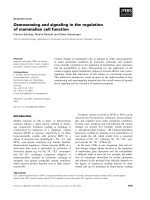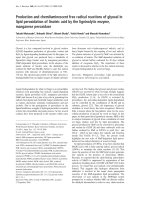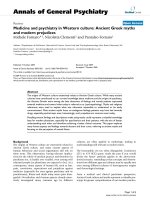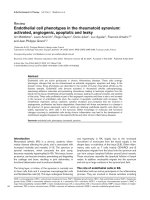Báo cáo y học: "Progress and Challenges in the Understanding of Chronic Urticaria" pptx
Bạn đang xem bản rút gọn của tài liệu. Xem và tải ngay bản đầy đủ của tài liệu tại đây (121.68 KB, 5 trang )
ORIGINAL ARTICLE
Progress and Challenges in the Understanding of Chronic
Urticaria
Marta Ferrer, MD, PhD and Allen P. Kaplan, MD
Chronic urticaria is a skin disorder characterized by transient pruritic weals that recur from day to day for 6 weeks or more. It has a
great impact on patients’ quality of life. In spite of this prevalence and morbidity, we are only beginning to understand its
physiopathology and we do not have a curative treatment. Moreover, a patient with chronic urticaria may undergo extensive
laboratory evaluations seeking a cause only to be frustrated when none is found. In recent years there have been significant advances
in our understanding of some of the molecular mechanisms responsible for hive formation. The presence and probable role of IgG
autoantibodies directed against epitopes expressed on the alpha-chain of the IgE receptor and to lesser extent, to IgE in a subset of
patients is generally acknowledged. These autoantibodies activate complement to release C5a, which augments histamine release,
and IL4 and leukotriene C4 are released as well. A perivascular cellular infiltrate results without predominance of either Th1 or Th2
lymphocyte subpopulations. Basophils of all chronic urticaria patients (autoimmune or idiopathic) are hyperresponsive to serum,
regardless of source, but poorly responsive to anti IgE. In this review we will summarize the recent contributions to this field and try
to provide insights to possible future directions for research on this disease.
Key words: autoimmunity, basophils, chronic urticaria, cotinine, IgE receptor, mast cells
C
hronic urticaria is a skin disorder characterized by
transient pruritic weals that recur from day to day for
6 weeks or more. We recently calculated a 0.6% (95%
confidence interval 0.4–0.8) prevalence in a population
study.
1
It has a great impact on patients’ quality of life,
2,3
to a degree equal to that experienced by sufferers from
triple-vessel coronary artery disease.
In spite of this prevalence and morbidity, we are only
beginning to understand its physiopathology and do not
have a curative treatment. Moreover, a patient with
chronic urticaria may undergo extensive laboratory
evaluations seeking a cause, only to be frustrated when
none is found.
The presence of antithyroid antibodies and early
observations regarding a 5 to 10% incidence of functional
anti–immunoglobulin (Ig)E antibodies suggested that
autoimmunity might have a role.
4,5
Hide et al corrobo-
rated the occasional presence of IgG anti-IgE and
demonstrated the presence of functional autoantibodies
against the alpha subunit of the IgE receptor in at least
one-third of patients.
6
These antibodies cause the release of
histamine and other mediators that are responsible for
urticaria and angioedema by activating blood basophils
and cutaneous mast cells.
7,8
The functional activity of the
autoantibodies is augmented in the presence of compo-
nents of the classic complement cascade,
9
with a critical
role for C5a.
10
The presence of functional antibody can be verified
either by the autologous skin test
11
or by the ability of
serum to degranulate basophils and mast cells. The
basophil histamine release assay appears to be the ‘‘gold
standard’’ for detecting functional autoantibodies in the
serum of patients with chronic urticaria since we found
both false-negative and false-positive results by binding
assays.
10,12
Thus, there were sera that had positive results
for anti–alpha subunit antibody by means of immuno-
blotting that were not capable of inducing any measurable
histamine release from human basophils. When we assayed
a large group of patients’ sera by both basophil histamine
release and immunoblot, the results did not correlate when
individual patients were assessed.
13
The reason for this
Marta Ferrer: Department of Allergy, Clinica Universitaria, Universidad
de Navarra, Pamplona, Spain; Allen P. Kaplan: National Allergy,
Asthma, and Urticaria Centers of Charleston, Charleston, South
Carolina.
This work was funded by a grant from the Fondo de Investigacio
´
n
Sanitaria, #03/0789.
Correspondence to: Dr. Marta Ferrer, Department of Allergy and Clinical
Immunology, Clinica Universitaria, Universidad de Navarra, Pio XII, 36,
31008-Pamplona, Spain; e-mail:
DOI 10.2310/7480.2006.00016
Allergy, Asthma, and Clinical Immunology, Vol 3, No 1 (Spring), 2007: pp 31–35 31
discrepancy is not clear. Although a cross-reaction of the
alpha subunit with tetanus toxoid was reported,
14
we
could not absorb the immunoblot band with tetanus
toxoid (unpublished observations, 1997). Furthermore, the
presence of natural anti–alpha antibodies in the sera of
healthy donors has been reported,
15
which might become
pathogenic depending on the state of occupancy of the Fce
receptor by its natural ligand IgE. Horn and colleagues
proposed that an imbalance between FceR1a occupancy
and natural anti-FceR1a antibodies may be implicated in
the pathogenesis of autoimmune urticaria.
16
On the other hand, when histamine release is
performed by incubating chronic urticaria sera with the
basophils of normal donors, the percentage that is positive
is 40 to 45%. Approximately 60% of patients’ sera are
negative, and these remain idiopathic. The pathogenic
mechanisms causing urticaria in these residual 60% of
patients remain unknown.
13
Sabroe and colleagues com-
pared functional and nonfunctional sera and found that
sera that were unable to activate basophils were not able to
activate mast cells either.
17
Thus, their lack of activity is
not caused by unresponsive basophils. The only difference
found was that those patients with functional antibodies
had higher severity scores and more intense inflammation
on skin biopsy.
Preincubation with interleukin (IL)-3 augments the
histamine release without affecting the percentage of
positive sera.
18
More recently, it was demonstrated that
some patients with chronic urticaria have IgG antibodies
against the eosinophil low-affinity IgE receptor (CD23),
which activate eosinophils and induce histamine release by
eosinophie cationic protein (ECP), major basic protein
(MBP), or other eosinophil cationic proteins.
19
However,
this has not yet been confirmed.
Autoimmunity is also supported by other observations.
A higher frequency of human leukocyte antigen (HLA)
class DR4 and DQ8 alleles is seen in patients with chronic
urticaria, consistent with a genetic predisposition to this
disease.
20
IL-4 Production from Mast Cells and Basophils on
Sera Stimulation
We found that IL-4 was higher in the sera of patients with
chronic urticaria (as well as atopic subjects) compared
with controls, whereas IL-5 and interferon (IFN)-c levels
were normal.
When we stimulated basophils from normal donors
with the sera of chronic urticaria patients, we observed that
those patients whose sera were able to activate basophils
and induce histamine release were also able to induce IL-4
production. In contrast, sera that were negative for
histamine release were unable to release IL-4 after
incubation with basophils. Thus, the capacity to stimulate
basophils to produce IL-4 was associated with the presence
of histamine-releasing autoantibodies. When we stimu-
lated mast cells, histamine, leukotrienes, and IL-4 were
produced, and activation of mast cells by chronic urticaria
sera was closely correlated with the ability to activate
basophils.
21
These observations agree with the study reported by
Yasnowsky and colleagues, who found CD203c expression
on incubation of basophils with chronic urticaria sera.
This expression correlated with basophil histamine
release.
22
Our data lend further support to the presence of
basophil and cutaneous mast cell activators, predomi-
nantly anti-FceRI, in the sera of patients with chronic
urticaria and demonstrate that such sera can lead to the
production of leukotrienes and IL-4 in addition to
histamine.
Our results also provide clues to explain the presence
of a perivascular cellular infiltrate that differentiates
chronic urticaria from other types of urticaria, such as
dermatographism.
23,24
The serum factor is responsible
not only for histamine release but also C5a, cytokines,
and, presumably, chemokines, all of which contribute to
the recruitment of cells.
25,26
The infiltrate resembles that
seen in the allergic late-phase response but is different
when examined closely.
27
The T lymphocytes are a
combination of T helper (Th)1 and Th 2 subtypes,
and neutrophils and monocytes are more prominent in
the lesions of chronic urticaria than in the late-phase
response.
Cytokine Production after Stimulation with
PMA–Ionomycin: Phenotypic Characterization of
the Cytokine-Producing Subpopulation
We next questioned to what degree the sera of patients
with chronic urticaria reflect the predominance of a Th1
or Th2 phenotype. We examined cytokine expression at
the single-cell level
28
and identified the T-cell subpopula-
tions involved employing anticytokine monoclonal anti-
bodies and flow cytometry. Thus, we could assess the
simultaneous production of different cytokines in the same
cell.
We stimulated lymphocytes from patients suffering
from chronic urticaria and lymphocytes from control
donors with phorbol 12 myristate 13 acetate (PMA)-
32 Allergy, Asthma, and Clinical Immunology, Volume 3, Number 1, 2007
ionomycin and found that CD4
+
lymphocytes from
patients with chronic urticaria produced significantly
higher amounts of IL-4 and IFN-c than healthy donor
lymphocytes. There was no difference in IL-4 or IFN-c
production by CD8
+
lymphocytes of patients versus
controls. We did not find significant differences when
comparing the ratio of IFN-c to IL-4 production by CD4
+
or CD8
+
lymphocytes of control subjects and urticaria
patients.
21
These data strengthen previous studies suggesting an
immune basis for chronic urticaria since we demonstrate
that the CD4
+
lymphocytes of patients with this disease are
activated (or primed) and release greater amounts of
cytokines employing a nonspecific stimulus. This finding is
consistent with the histology found in biopsies of chronic
urticaria lesions, where a CD4
+
predominant infiltrate is
found.
29
Although PMA-I-induced activation is not a physiolo-
gic stimulus, previous studies indicate that the cytokine
phenotype reflects the physiologic potential for cellular
cytokine production. The cytokine profile found in our
study does not reflect either a Th1 or a Th2 predominance.
This conclusion is similar to that of a study in which the
authors analyzed skin biopsies of chronic urticaria patients
by in situ hybridization. IL-4, IL-5, and IFN-c probes
revealed higher cytokine messenger ribonucleic acid
expression in chronic urticaria patients than in healthy
controls, without a predominance of either a Th1 or a Th2
profile. The cellular infiltrate associated with chronic
urticaria was interpreted to represent either a Th0 profile
27
or a mixture of activated Th1 and Th2 cells.
Study on Releasability of Chronic Urticaria
Basophils
However, 60% of patients with chronic urticaria lacking
any detectable autoantibody (or other serologic abnorm-
ality), who are designated ‘‘idiopathic’’
30
since no alter-
native etiology has been found, remain. We therefore
compared the basophils of chronic urticaria patients with
the basophils derived from normal donors, hoping to
identify a basophil abnormality that might distinguish
patients with idiopathic urticaria from patients with
autoimmune urticaria.
A basophil abnormality is of particular interest because
some patients with chronic urticaria have basopenia
31
and
hyporesponsiveness to anti-IgE suggested by in vivo
desensitization.
32
For that purpose, we examined the
response of basophils of healthy donors, atopic donors,
and patients with chronic urticaria to a variety of stimuli,
including anti-IgE, bradykinin,
33
monocyte chemotactic
protein (MCP)-1,
34
C5a,
9,10,35
and serum.
Our data
36
support previous reports indicating that
the basophils of patients have a diminished response to
anti-IgE
37–39
and, to a lesser degree, to C5a. No differences
were observed when the basophils from patients were
incubated with bradykinin or MCP-1.
36
These results are
not due to a variation in histamine content since we did
not find significant differences between healthy control
and urticaria basophils. We did, however, observe higher
total histamine content and spontaneously released
histamine when the basophils of atopic subjects were
compared with the basophils of healthy controls or
patients with chronic urticaria. These results are consistent
with those published by Wahn and Zuberbier and their
colleagues.
40,41
Although the basophils of chronic urticaria patients
seem to be less responsive to stimuli, such as anti-IgE or
C5a, which act through different receptors, the abnorm-
ality does not seem to be due to a general impairment of
signaling since chronic urticaria basophils respond nor-
mally to other stimuli that act independently from the IgE
receptor, such as A23187, formyl-met-leu-phe (FMLP),
and platelet-activating factor,
41
in addition to bradykinin
33
and MCP-1.
42
Hyperresponsiveness of Chronic Urticaria Basophils
When Incubated with Sera
Surprisingly, we observed prominent histamine release
when the basophils of chronic urticaria patients were
stimulated with other sera regardless of the source. Thus,
striking histamine release was obtained with sera derived
from patients with chronic idiopathic urticaria or chronic
autoimmune urticaria or even with normal control sera.
These results indicate that the basophils of chronic
urticaria patients are more responsive to some constituent
of serum regardless of the source. Basophils derived from
patients with chronic idiopathic urticaria were just as
abnormal as basophils from patients with chronic auto-
immune urticaria. Both groups of basophil were equally
responsive to bradykinin, C5a, MCP-1, or serum.
36
Both
groups were also hyporesponsive to anti-IgE; thus, in vivo
desensitization owing to the presence of an autoantibody
does not seem to be the explanation.
Hence, chronic urticaria basophils, in spite of being less
responsive to some stimuli, are clearly highly responsive
when incubated with sera, even normal sera. One could
argue that this effect might be due to variability in donor
basophil histamine release; however, our study employed
Ferrer and Kaplan, Progress and Challenges in the Understanding of Chronic Urticaria 33
the same basophil preparation incubated with different
stimuli. When different basophil preparations were
compared, the counts were similar, and the results were
strikingly consistent for all of the chronic urticaria
basophils studied.
Conclusion
Chronic urticaria is now divided into the autoimmune and
idiopathic subgroups. Autoimmunity is dependent on the
presence of IgG antibody to the alpha subunit of the IgE
receptor and, to a lesser degree, anti-IgE. Such sera release
histamine, leukotrienes, and IL-4 from donor basophils.
However, stimulation of T lymphocytes releases both IL-4
and IFN-c, and the histology of biopsy specimens does not
have a predominance of Th1 or Th2 subtypes, although
most cells are CD4
+
rather than CD8
+
.
Chronic urticaria basophils have several specific
features that distinguish them from the basophils of
healthy donors or atopic controls. They are less responsive
to anti-IgE and C5a, with no difference when stimulated
with bradykinin and MCP-1, and have much higher release
when incubated with serum. The factor in serum that
stimulates these cells has not been identified, nor is the
abnormal responsiveness of the cells understood. One
study has, however, suggested a signal abnormality
involving Ras in chronic urticaria basophils.
43
The other
known basophil abnormality in chronic urticaria is
basopenia.
31,44
Although 55% of chronic urticaria patients are still
considered idiopathic since the etiology is obscure,
including the absence of autoantibodies, this is the first
demonstration that the basophils of this group share
abnormal responsiveness with the basophils of patients
with chronic autoimmune urticaria, just as the histology of
the two groups is strikingly similar.
27,45
All of these findings provide a basis for further
investigation of the pathogenesis and treatment of this
disease.
46–48
References
1. Gaig P, Olona M, Mun
˜
oz Lejarazu D, et al. Epidemiology of
urticaria in Spain. J Invest Allergol Clin Immunol 2004;14:342–5.
2. O’Donnell BF, Lawlor F, Simpson J, et al. The impact of chronic
urticaria on the quality of life. Br J Dermatol 1997;136:197–201.
3. Grob JJ, Gaudy-Marqueste C. Urticaria and quality of life. Clin Rev
Allergy Immunol 2006;30:47–51.
4. Leznoff A, Josse RG, Denburg J, Dolovich J. Association of chronic
urticaria and angioedema with thyroid autoimmunity. Arch
Dermatol 1983;119:636–40.
5. Gruber BL, Baeza ML, Marchese MJ, et al. Prevalence and
functional role of anti-IgE autoantibodies in urticarial syndromes.
J Invest Dermatol 1988;90:213–7.
6. Hide M, Francis DM, Grattan CE, et al. Autoantibodies against the
high-affinity IgE receptor as a cause of histamine release in chronic
urticaria. N Engl J Med 1993;328:1599–604.
7. Niimi N, Francis DM, Kermani F, et al. Dermal mast cell activation
by autoantibodies against the high affinity IgE receptor in chronic
urticaria. J Invest Dermatol 1996;106:1001–6.
8. Ferrer M, Kinet JP, Kaplan AP. Comparative studies of functional
and binding assays for IgG anti-Fc(epsilon)RIalpha (alpha-
subunit) in chronic urticaria. J Allergy Clin Immunol 1998;101:
672–6.
9. Ferrer M, Nakazawa K, Kaplan AP. Complement dependence of
histamine release in chronic urticaria. J Allergy Clin Immunol
1999;104:169–72.
10. Kikuchi Y, Kaplan AP. A role for C5a in augmenting IgG-
dependent histamine release from basophils in chronic urticaria. J
Allergy Clin Immunol 2002;109:114–8.
11. Sabroe RA, Grattan CE, Francis DM, et al. The autologous serum
skin test: a screening test for autoantibodies in chronic idiopathic
urticaria. Br J Dermatol 1999;140:446–52.
12. Fiebiger E, Hammerschmid F, Stingl G, Maurer D. Anti-
FcepsilonRIalpha autoantibodies in autoimmune-mediated dis-
orders. Identification of a structure-function relationship. J Clin
Invest 1998;101:243–51.
13. Kikuchi Y, Kaplan AP. Mechanisms of autoimmune activation of
basophils in chronic urticaria. J Allergy Clin Immunol 2001;107:
1056–62.
14. Horn MP, Gerster TF, Ochensberger BF, et al. Human anti-
FcepsilonRIalpha autoantibodies isolated from healthy donors
cross-react with tetanus toxoid. Eur J Immunol 1999;29:1139–48.
15. Pachlopnik JM, Horn MP, Fux M, et al. Natural anti-
Fc[epsiv]RI[alpha] autoantibodies may interfere with diagnostic
tests for autoimmune urticaria. J Autoimmun 2004;22:43–51.
16. Horn MP, Pachlopnik JM, Vogel M, et al. Conditional
autoimmunity mediated by human natural anti-FceRIa autoanti-
bodies? FASEB J 2001;15:2268–74.
17. Sabroe RA, Fiebiger E, Francis DM, et al. Classification of anti-
FcepsilonRI and anti-IgE autoantibodies in chronic idiopathic
urticaria and correlation with disease severity. J Allergy Clin
Immunol 2002;110:492–9.
18. Ferrer M, Luquin E, Kaplan AP. IL3 effect on basophils histamine
release upon stimulation with chronic urticaria sera. Allergy 2003;
58:802–7.
19. Puccetti A, Bason C, Simeoni S, et al. In chronic idiopathic
urticaria autoantibodies against FceRII/CD23 induce histamine
release via eosinophil activation. Clin Exp Allergy 2005;35:1599–
607.
20. O’Donnell BF, O’Neill CM, Francis DM, et al. Human leucocyte
antigen class II associations in chronic idiopathic urticaria. Br J
Dermatol 1999;140:853–8.
21. Ferrer M, Luquin E, Sanchez-Ibarrola A, et al. Secretion of
cytokines, histamine and leukotrienes in chronic urticaria. Int Arch
Allergy Immunol 2002;129:254–60.
22. Yasnowsky KM, Dreskin SC, Efaw B, et al. Chronic urticaria sera
increase basophil CD203c expression. J Allergy Clin Immunol
2006;117:1430–4.
34 Allergy, Asthma, and Clinical Immunology, Volume 3, Number 1, 2007
23. Stewart GE. Histopathology of chronic urticaria. Clin Rev Allergy
Immunol 2002;23:195–200.
24. Natbony SF, Phillips ME, Elias JM, et al. Histologic studies of
chronic idiopathic urticaria. J Allergy Clin Immunol 1983;71:177–
83.
25. Hermes B, Prochazka AK, Haas N, et al. Upregulation of TNF-
alpha and IL-3 expression in lesional and uninvolved skin in
different types of urticaria. J Allergy Clin Immunol 1999;103:307–
14.
26. Haas N, Toppe E, Henz BM. Microscopic morphology of different
types of urticaria. Arch Dermatol 1998;134:41–6.
27. Ying S, Kikuchi Y, Meng Q, et al. TH1/TH2 cytokines and
inflammatory cells in skin biopsy specimens from patients with
chronic idiopathic urticaria: comparison with the allergen-induced
late-phase cutaneous reaction. J Allergy Clin Immunol 2002;109:
694–700.
28. Openshaw P, Murphy EE, Hosken NA, et al. Heterogeneity of
intracellular cytokine synthesis at the single-cell level in polarized
T helper 1 and T helper 2 populations. J Exp Med 1995;182:1357–
67.
29. Barlow RJ, Ross EL, MacDonald DM, et al. Mast cells and T
lymphocytes in chronic urticaria. Clin Exp Allergy 1995;25:317–22.
30. Grattan CE, Sabroe RA, Greaves MW. Chronic urticaria. J Am
Acad Dermatol 2002;46:645–57.
31. Grattan CE, Walpole D, Francis DM, et al. Flow cytometric
analysis of basophil numbers in chronic urticaria: basopenia is
related to serum histamine releasing activity. Clin Exp Allergy
1997;27:1417–24.
32. Plaut M, Kazimierczak W, Lichtenstein LM. Abnormalities of
basophil ‘‘releasability’’ in atopic and asthmatic individuals. J
Allergy Clin Immunol 1986;78:968–73.
33. Lawrence ID, Warner JA, Cohan VL, et al. Bradykinin analog
induces histamine release from human skin mast cells. Adv Exp
Med Biol 1989;247:225–9.
34. Alam R, Forsythe P, Stafford S, et al. Monocyte chemotactic
protein-2, monocyte chemotactic protein-3, and fibroblast-
induced cytokine. Three new chemokines induce chemotaxis and
activation of basophils. J Immunol 1994;153:3155–9.
35. Fureder W, Agis H, Willheim M, et al. Differential expression of
complement receptors on human basophils and mast cells.
Evidence for mast cell heterogeneity and CD88/C5aR expression
on skin mast cells. J Immunol 1995;155:3152–60.
36. Luquin E, Kaplan AP, Ferrer M. Increased responsiveness of
basophils of patients with chronic urticaria to sera but hypo-
responsiveness to other stimuli. Clin Exp Allergy 2005;35:456–60.
37. Kern F, Lichtenstein LM. Defective histamine release in chronic
urticaria. J Clin Invest 1976;57:1369–77.
38. Bischoff SC, Zwahlen R, Stucki M, et al. Basophil histamine release
and leukotriene production in response to anti-IgE and anti-IgE
receptor antibodies. Comparison of normal subjects and patients
with urticaria, atopic dermatitis or bronchial asthma. Int Arch
Allergy Immunol 1996;110:261–71.
39. Greaves MW, Plummer VM, McLaughlan P, Stanworth DR.
Serum and cell bound IgE in chronic urticaria. Clin Allergy 1974;4:
265–71.
40. Wahn U, Ernsting M, Peterson J. Spontaneous histamine release
from washed leukocytes and whole blood in atopic and non-atopic
individuals. Allergy 1990;45:109–14.
41. Zuberbier T, Schwarz S, Hartmann K, et al. Histamine releasability
of basophils and skin mast cells in chronic urticaria. Allergy 1996;
51:24–8.
42. Alam R, Lett-Brown MA, Forsythe PA, et al. Monocyte
chemotactic and activating factor is a potent histamine-releasing
factor for basophils. J Clin Invest 1992;89:723–8.
43. Confino-Cohen R, Aharoni D, Goldberg A, et al. Evidence for
aberrant regulation of the p21Ras pathway in PBMCs of patients
with chronic idiopathic urticaria. J Allergy Clin Immunol 2002;
109:349–56.
44. Grattan CE, Dawn G, Gibbs S, Francis DM. Blood basophil
numbers in chronic ordinary urticaria and healthy controls:
diurnal variation, influence of loratadine and prednisolone and
relationship to disease activity. Clin Exp Allergy 2003;33:337–41.
45. Sabroe RA, Poon E, Orchard GE, et al. Cutaneous inflammatory
cell infiltrate in chronic idiopathic urticaria: comparison of
patients with and without anti-FcepsilonRI or anti-IgE autoanti-
bodies. J Allergy Clin Immunol 1999;103:484–93.
46. Marsland AM, Soundararajan S, Joseph K, Kaplan AP. Effects of
calcineurin inhibitors on an in vitro assay for chronic urticaria.
Clin Exp Allergy 2005;35:554–9.
47. O’Donnell BF, Barr RM, Black AK, et al. Intravenous immuno-
globulin in autoimmune chronic urticaria. Br J Dermatol 1998;138:
101–6.
48. Kessel A, Bamberger E, Toubi E. Tacrolimus in the treatment of
severe chronic idiopathic urticaria: an open-label prospective
study. J Am Acad Dermatol 2005;52:145–8.
Ferrer and Kaplan, Progress and Challenges in the Understanding of Chronic Urticaria 35









